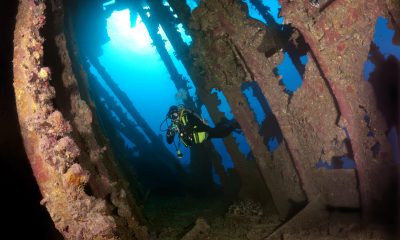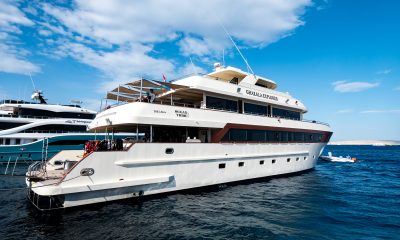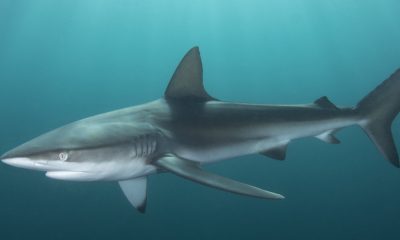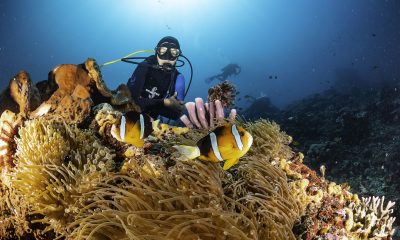News
Being Horizontal… ‘Cave Trim’ – the elusive goal
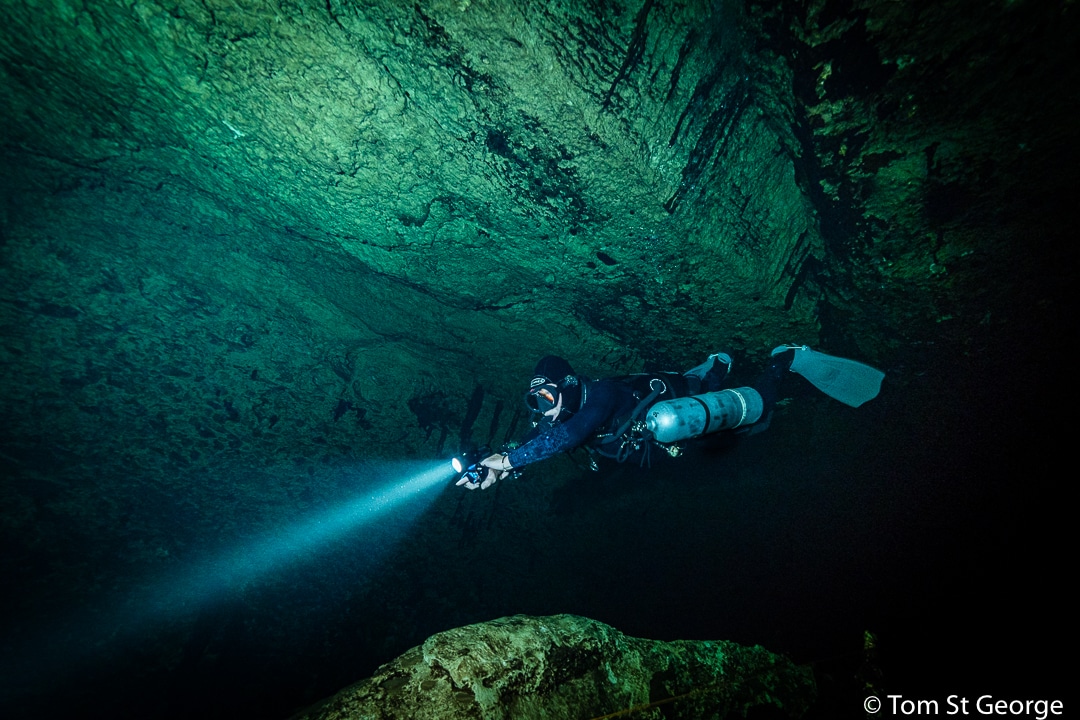
Watch a group of well-trained divers in the water — especially cave divers or technical divers — and you’ll notice they look a little different to most casual sport divers.
How different?
Well, the cave/technical/well-trained sport divers will be lying on the water (usually horizontal) rather than standing in it. Here’s what I mean:
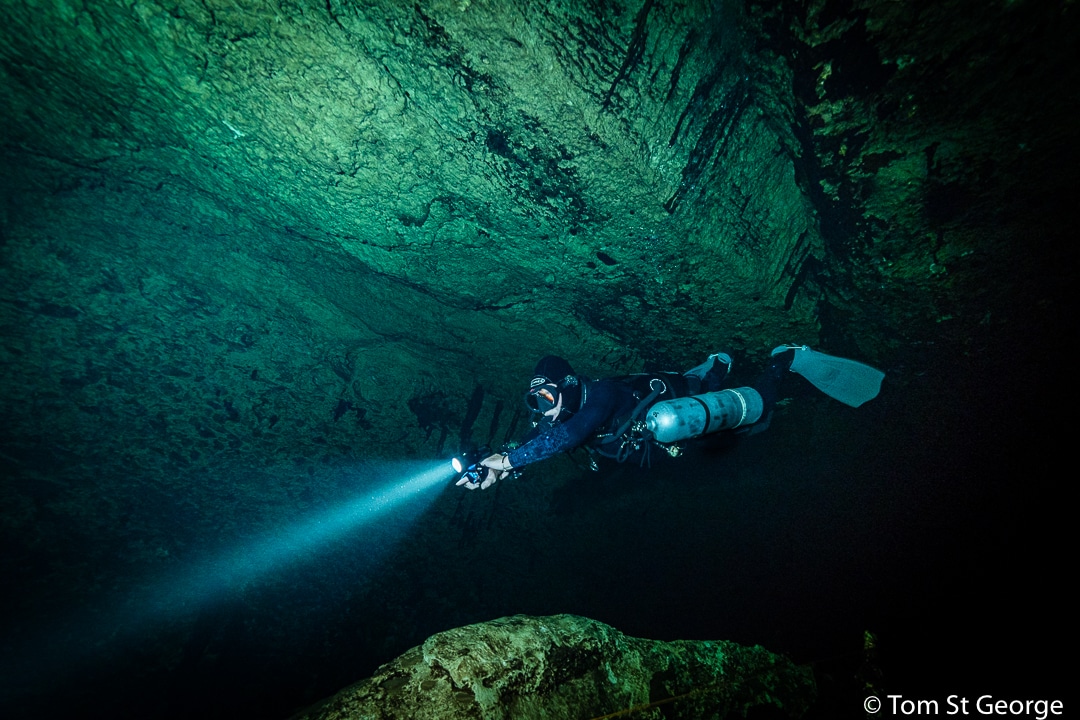
A typical cave diver in trim… lying on the water
Photo: Tom St George
And here’s a picture of a group with a different in-water attitude:
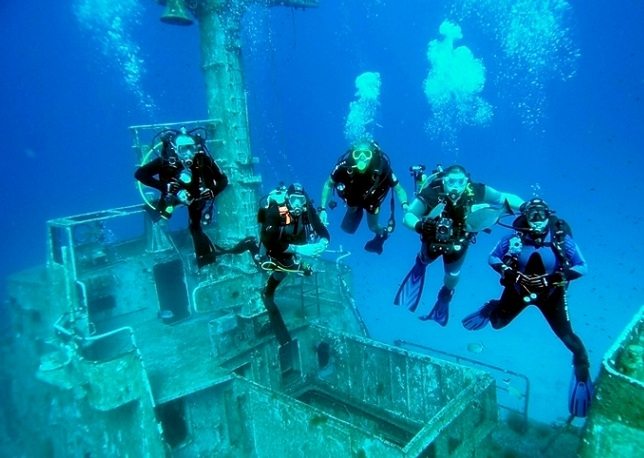
A diver enjoying the water but working hard…
Photo: Dean McConnachie
So, let’s assume you’re not looking at those pictures and saying to yourself: “What’s the big deal?” Or “I can’t see any difference.”
Given that, let’s also assume you are interested in finding out why cave trim is preferred over the other. It’s not that anything other than horizontal is wrong. It’s just there’s something easier and better. (For the record, horizontal trim is not always exactly horizontal — occasionally the correct attitude in the water is head or feet down at varying angles for short periods — but it is the default.
Reason one to be horizontal: moving through the water is easier. You are streamlined and therefore water resistance moving ahead and backwards is at a minimum. Even with extra gear (more bottles, pockets full of tools and spanners, a pouch with backup mask, spare dive computer, lights, bits of string and a chicken sandwich), moving through the water in any direction is easier compared to swimming at it full-frontal. When a diver is streamlined, the thrust from each and every fin kick is translated into graceful movement. Progress from point A to point B and back again is more efficient, less work, uses less energy, uses less gas.
Reason two: when a diver’s flat in the water, she meets maximum water resistance going up or down. This helps her maintain position in the water column. Of course, this is a small effect compared to having buoyancy dialled in, but it’s nevertheless a factor.
One salient point when comparing cave trim to fins down orientation, is that being horizontal teaches good habits regarding buoyancy control. There is no temptation to kick to stay in place as there is with fins-down orientation. (For example, although the group picture above isn’t a video, I’d lay dollars to donuts that the two divers on the left and the one on the right are all working hard to maintain their position in the water column while the picture is being taken. They seem to have poor buoyancy control, and staying in place is an effort for them.
The cave diver pictured above is motionless, and literally hanging in the water waiting for the photographer — Tom St. George — to signal “okay. Got it!”)
Reason three: a diver in horizontal trim is much less likely to stir up silt and mud or damage whatever is below them. In fact, when using the correct propulsion technique (frog kick generally) and by keeping the knees bent and thighs parallel to her lateral line, a diver can be a hand’s breadth from the bottom and move without disturbing anything at all. This diagram may help illustrate the point.
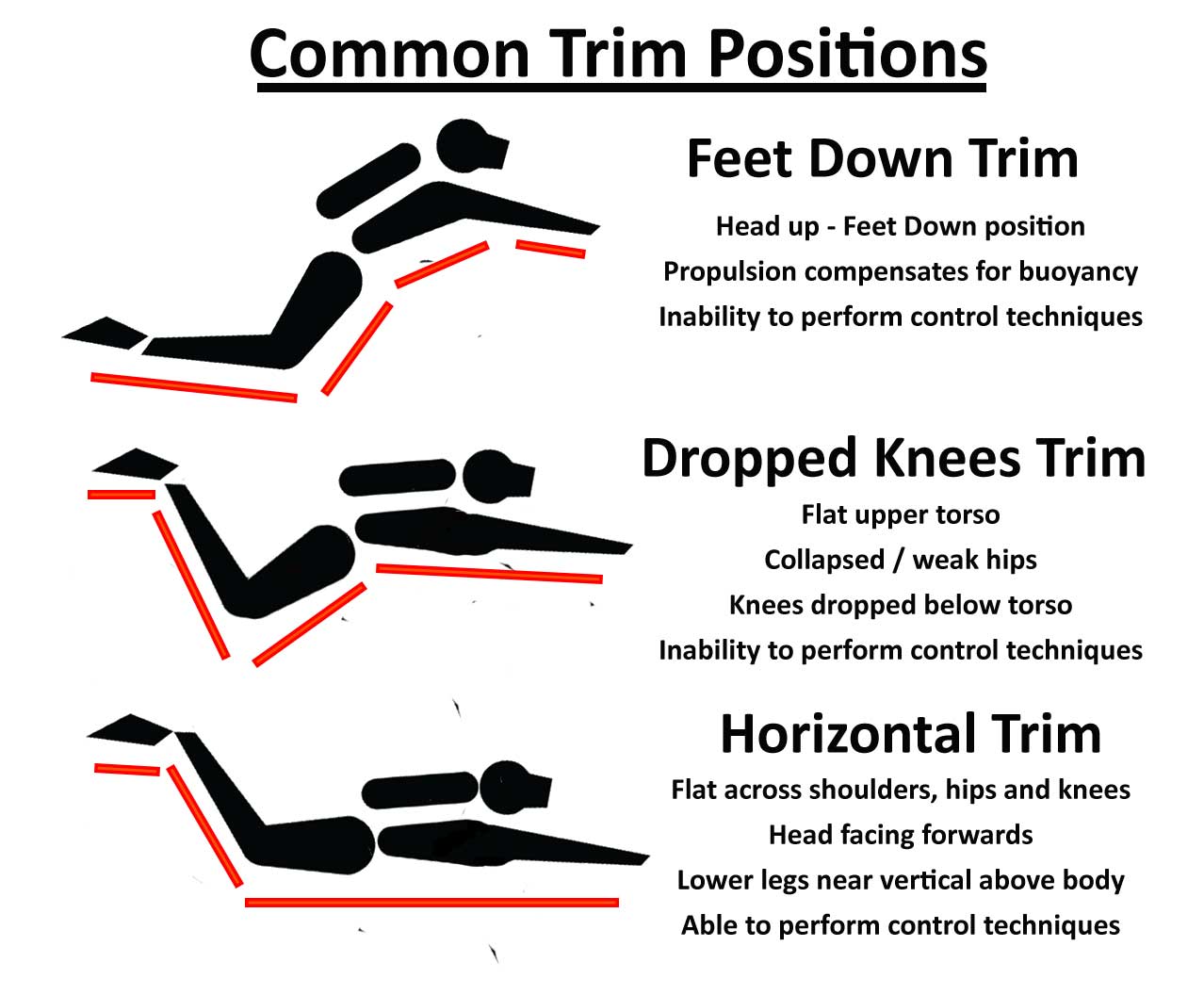
When in horizontal trim, arch the back slightly by clenching your butt cheeks… think “Flamenco Dancer Skydiving.”
Illustration courtesy of Andy Davis, Scuba Tech Philippines
Okay, so how does one attain horizontal trim?
In a word: practice.
In more detail: commitment and practice!
Practice needs little explanation. Be patient, spend the time. A great approach is to dedicate a few dives to nothing but working on trim.
For an in-water exercise, get to a pool or shallow, calm waters, and dive with a buddy who has an underwater video camera to track your progress. Start by resting prone on a flat ledge or the pool bottom and gradually add a little lift to your buoyancy cell.
Critical to mastery is sticking to it (that’s the commitment), that and understanding the relationship between four things: gravity, buoyancy, you, your gear.
Essentially, you need to balance each of these things to come up with a perfect result. Luckily, two of them are constants and pull in exactly opposite directions. Gravity pulls you deeper, buoyancy pulls you towards the surface.
Simple… well, almost. What complicates matters are the other two things: you and the gear you are wearing.
Now let’s just say for brevity, you have reached the point where you have gravity and buoyancy perfectly balanced. Something called neutral buoyancy. You are not overweighted. You are not under-weighted. And in shallow water you are able to hover without moving your hands and feet.
At this point — hovering — you’re off to a great start. But now you need to get horizontal and stay there without moving your hands or feet (don’t scull, don’t swim, just hang in the water). Try it. If you’re lucky, it will work. Most likely though you’ll either tilt head down or feet down.
Let’s think about that situation for a minute.
As a for instance, say you need two kilos of ballast (lead weight) to achieve neutrality. These weights are over and above the ballast that’s a result of your scuba cylinders, lights, reels, and all the other crap we carry with us on a dive.
Now, divers usually carry lead ballast around their waist, so let’s says yours is about your mid-point. Now consider what would happen if we were to move that weight to the ends of your fins. Your feet would naturally swing down pulling you, your body, your kit, into a straight up and down orientation. Kind of similar to what happens when a “robust” child get on one end of a teeter-totter (a see-saw) and the “runt of the litter” is sitting on the opposite end.
Okay, so what would happen if you were silly enough to put the weights on your mask strap. Well, to begin with you’d orient head down and then your mask would most likely fall off. Goodbye mask. But if we think about the see-saw situation, same deal except now runt’s pet elephant is sitting on his lap and Robusto is up in the air.
You get the point. You are dealing with a lever. To achieve balance, either the weights on both ends have to be similar, or the distance from the balance point — the fulcrum — has to compensate for any difference. That’s to say, moving stuff that sinks in the water — weights in this instance, but also all the other bits and pieces of kit — is going to have a direct effect on in-water orientation.
Weights sink, so do scuba cylinders, lights, cameras, and a whole lot more including the gas we breathe (more than 2.5 kilos of “air” in a standard aluminium 11-litre tank for example). Understanding that moving each of these things away from your balance point has the potential to influence trim is key.
To achieve cave trim you want balance. Moving things around — even swapping light fins for heavier ones — can make that happen… or not.
But before that, you perhaps should consider things that have an effect on buoyancy: lungs, buoyancy cell (BCD, wing, etc.), drysuit, thick wetsuit. And each of these is a variable.
Also — and this is where things get interesting — things that are buoyant supply lift and the location of that lift can have an influence on trim as well. (Ask a new drysuit diver about their experience with floaty feet.)
You can experience something similar by moving a cylinder up and down in its retaining straps on a standard BCD.
All this serves to show us that the see-saw analogy used earlier may actually be an over simplification. It would be better to think of a fully kitted diver as a beam with a variable balance point rather than a simple lever with a fixed fulcrum.
Hang on. This has started to get a little over-the-top and way too complicated to explain without using Venn diagrams and video. No worries. Let’s stop now while we’re ahead because in truth, the take-away is essentially unchanged. You have the basics. Now let’s get in the water and practice.
Steve Lewis’s new book, Death in Number Two Shaft: the underwater exploration of Newfoundland’s Bell Island Mine, is available now on Steve’s website or from Amazon UK.
Find out more about Steve at www.techdivertraining.org.
News
Dive Worldwide Announces Bite-Back as its Charity of the Year

Over the next 12 months, specialist scuba holiday company Dive Worldwide will be supporting Bite-Back Shark & Marine Conservation with donations collected from client bookings to any one of its stunning dive destinations around the world. The independently-owned operator expects to raise £3000 for the UK charity.
Manager at Dive Worldwide, Phil North, said: “We’re especially excited to work with Bite-Back and support its intelligent, creative and results-driven campaigns to end the UK trade in shark products and prompt a change in attitudes to the ocean’s most maligned inhabitant.”
Bite-Back is running campaigns to hold the media to account on the way it reports shark news along with a brand new nationwide education programme. Last year the charity was credited for spearheading a UK ban on the import and export of shark fins.
Campaign director at Bite-Back, Graham Buckingham, said: “We’re enormously grateful to Dive Worldwide for choosing to support Bite-Back. The company’s commitment to conservation helps set it apart from other tour operators and we’re certain its clients admire and respect that policy. For us, the affiliation is huge and helps us look to the future with confidence we can deliver against key conservation programmes.”
To launch the fundraising initiative, Phil North presented Graham Buckingham with a cheque for £1,000.
Visit Dive Worldwide to discover its diverse range of international scuba adventures and visit Bite-Back to learn more about the charity’s campaigns.
MORE INFORMATION
Call Graham Buckingham on 07810 454 266 or email graham@bite-back.com
Gear News
Scubapro Free Octopus Promotion 2024

Free Octopus with every purchase of a SCUBAPRO regulator system
Just in time for the spring season, divers can save money with the FREE OCTOPUS SPRING PROMOTION! Until July 31st SCUBAPRO offers an Octopus for free
with every purchase of a regulator system!
Get a free S270 OCTOPUS with purchase of these combinations:
MK25 EVO or MK19 EVO with A700
MK25 EVO or MK19 EVO with S620Ti
MK25 EVO or MK19 EVO with D420
MK25 EVO Din mit S620Ti-X
Get a free R105 OCTOPUS with purchase of the following combinations:
MK25 EVO or MK19 EVO with G260
MK25 EVO or MK17 EVO with S600
SCUBAPRO offers a 30-year first owner warranty on all regulators, with a revision period of two years or 100 dives. All SCUBAPRO regulators are of course certified according to the new European test standard EN250-2014.
Available at participating SCUBAPRO dealers. Promotion may not be available in all regions. Find an authorized SCUBAPRO Dealer at scubapro.com.
More information available on www.scubapro.com.
-
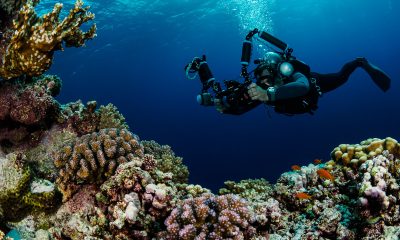
 News3 months ago
News3 months agoHone your underwater photography skills with Alphamarine Photography at Red Sea Diving Safari in March
-
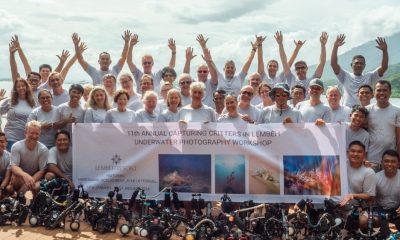
 News3 months ago
News3 months agoCapturing Critters in Lembeh Underwater Photography Workshop 2024: Event Roundup
-
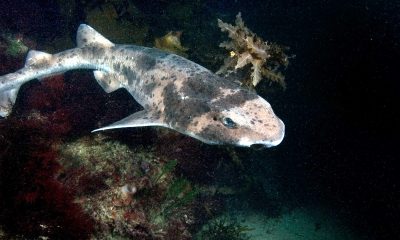
 Marine Life & Conservation Blogs3 months ago
Marine Life & Conservation Blogs3 months agoCreature Feature: Swell Sharks
-
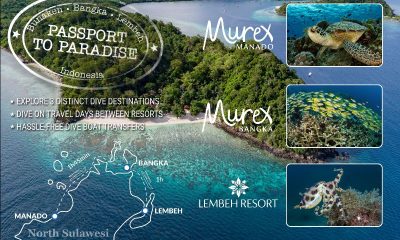
 Blogs2 months ago
Blogs2 months agoMurex Resorts: Passport to Paradise!
-
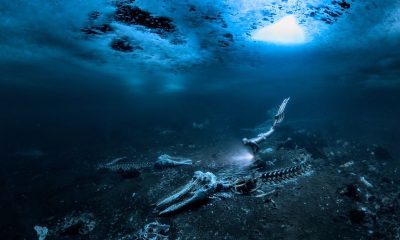
 Blogs2 months ago
Blogs2 months agoDiver Discovering Whale Skeletons Beneath Ice Judged World’s Best Underwater Photograph
-
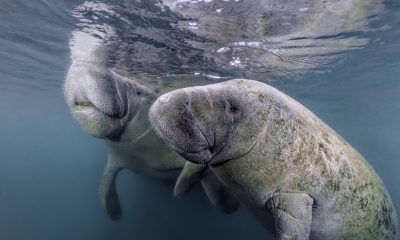
 Marine Life & Conservation2 months ago
Marine Life & Conservation2 months agoSave the Manatee Club launches brand new webcams at Silver Springs State Park, Florida
-
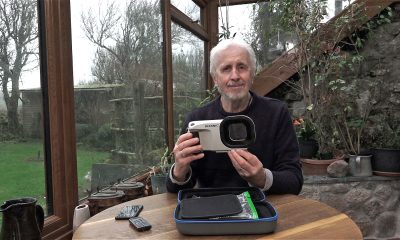
 Gear Reviews3 months ago
Gear Reviews3 months agoGear Review: Oceanic+ Dive Housing for iPhone
-
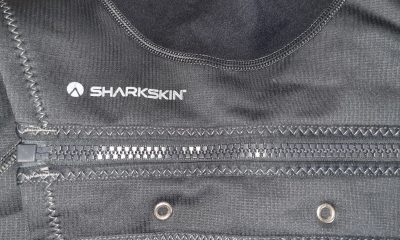
 Gear Reviews2 weeks ago
Gear Reviews2 weeks agoGEAR REVIEW – Revolutionising Diving Comfort: The Sharkskin T2 Chillproof Suit





